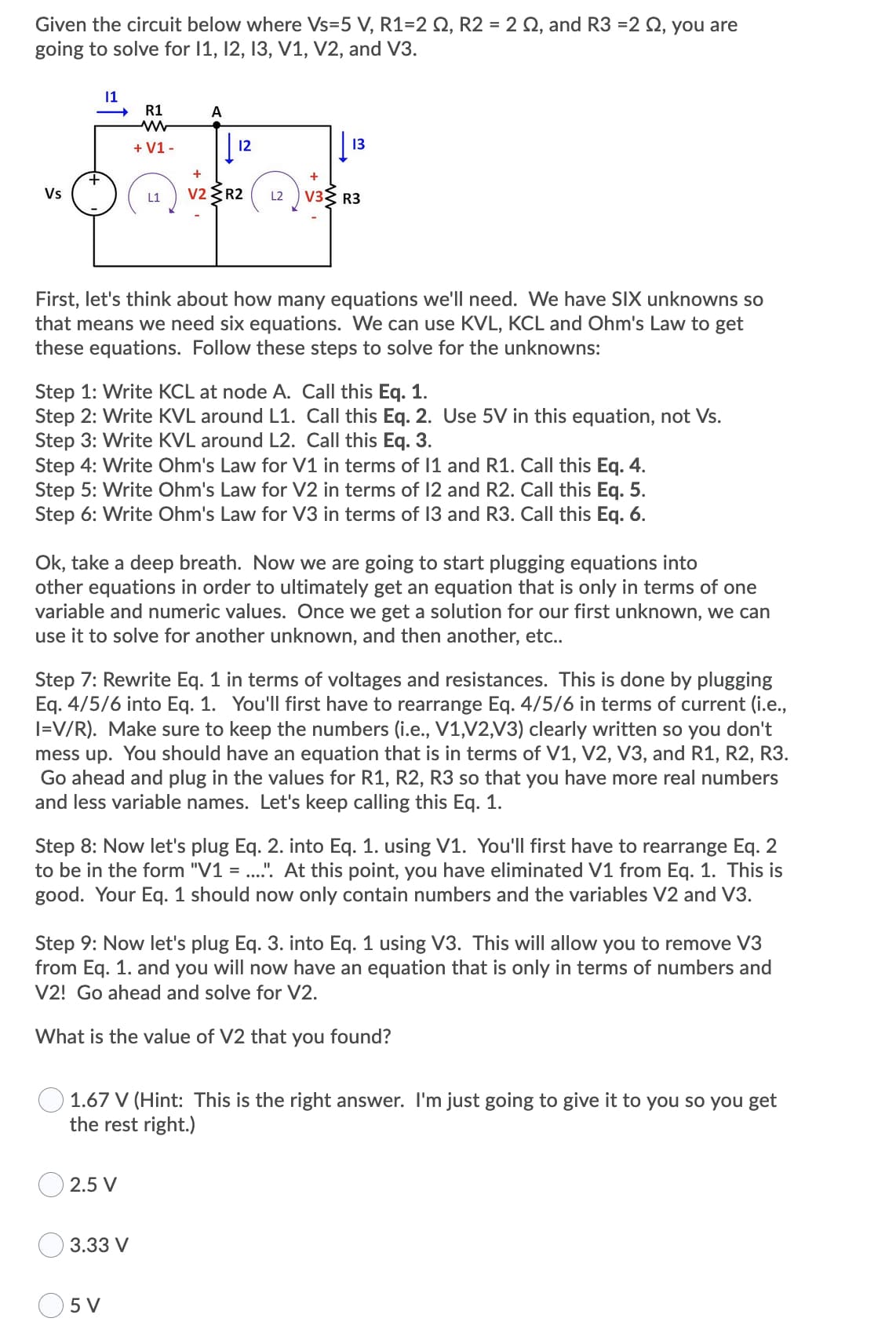Given the circuit below where Vs=5 V, R1=2 Q, R2 = 2 Q, and R3 =2 Q, you are going to solve for 1, 12, 13, V1, V2, and V3. 11 R1 A + V1 - 13 + Vs v2 R2 V3 R3 L1 L2
Given the circuit below where Vs=5 V, R1=2 Q, R2 = 2 Q, and R3 =2 Q, you are going to solve for 1, 12, 13, V1, V2, and V3. 11 R1 A + V1 - 13 + Vs v2 R2 V3 R3 L1 L2
Introductory Circuit Analysis (13th Edition)
13th Edition
ISBN:9780133923605
Author:Robert L. Boylestad
Publisher:Robert L. Boylestad
Chapter1: Introduction
Section: Chapter Questions
Problem 1P: Visit your local library (at school or home) and describe the extent to which it provides literature...
Related questions
Question

Transcribed Image Text:Given the circuit below where Vs=5 V, R1=2 Q, R2 = 2 Q, and R3 =2 Q, you are
going to solve for 1, 12, 13, V1, V2, and V3.
11
R1
A
+ V1 -
12
13
V2 R2
V33 R3
Vs
L1
L2
First, let's think about how many equations we'll need. We have SIX unknowns so
that means we need six equations. We can use KVL, KCL and Ohm's Law to get
these equations. Follow these steps to solve for the unknowns:
Step 1: Write KCL at node A. Call this Eq. 1.
Step 2: Write KVL around L1. Call this Eq. 2. Use 5V in this equation, not Vs.
Step 3: Write KVL around L2. Call this Eq. 3.
Step 4: Write Ohm's Law for V1 in terms of 1 and R1. Call this Eq. 4.
Step 5: Write Ohm's Law for V2 in terms of 12 and R2. Call this Eg. 5.
Step 6: Write Ohm's Law for V3 in terms of 13 and R3. Call this Eg. 6.
Ok, take a deep breath. Now we are going to start plugging equations into
other equations in order to ultimately get an equation that is only in terms of one
variable and numeric values. Once we get a solution for our first unknown, we can
use it to solve for another unknown, and then another, etc..
Step 7: Rewrite Eq. 1 in terms of voltages and resistances. This is done by plugging
Eq. 4/5/6 into Eq. 1. You'll first have to rearrange Eq. 4/5/6 in terms of current (i.e.,
I=V/R). Make sure to keep the numbers (i.e., V1,V2,V3) clearly written so you don't
mess up. You should have an equation that is in terms of V1, V2, V3, and R1, R2, R3.
Go ahead and plug in the values for R1, R2, R3 so that you have more real numbers
and less variable names. Let's keep calling this Eq. 1.
Step 8: Now let's plug Eq. 2. into Eq. 1. using V1. You'll first have to rearrange Eq. 2
to be in the form "V1 = ..". At this point, you have eliminated V1 from Eq. 1. This is
good. Your Eq. 1 should now only contain numbers and the variables V2 and V3.
Step 9: Now let's plug Eq. 3. into Eq. 1 using V3. This will allow you to remove V3
from Eq. 1. and you will now have an equation that is only in terms of numbers and
V2! Go ahead and solve for V2.
What is the value of V2 that you found?
1.67 V (Hint: This is the right answer. I'm just going to give it to you so you get
the rest right.)
2.5 V
3.33 V
5 V
Expert Solution
This question has been solved!
Explore an expertly crafted, step-by-step solution for a thorough understanding of key concepts.
This is a popular solution!
Trending now
This is a popular solution!
Step by step
Solved in 2 steps with 2 images

Recommended textbooks for you

Introductory Circuit Analysis (13th Edition)
Electrical Engineering
ISBN:
9780133923605
Author:
Robert L. Boylestad
Publisher:
PEARSON

Delmar's Standard Textbook Of Electricity
Electrical Engineering
ISBN:
9781337900348
Author:
Stephen L. Herman
Publisher:
Cengage Learning

Programmable Logic Controllers
Electrical Engineering
ISBN:
9780073373843
Author:
Frank D. Petruzella
Publisher:
McGraw-Hill Education

Introductory Circuit Analysis (13th Edition)
Electrical Engineering
ISBN:
9780133923605
Author:
Robert L. Boylestad
Publisher:
PEARSON

Delmar's Standard Textbook Of Electricity
Electrical Engineering
ISBN:
9781337900348
Author:
Stephen L. Herman
Publisher:
Cengage Learning

Programmable Logic Controllers
Electrical Engineering
ISBN:
9780073373843
Author:
Frank D. Petruzella
Publisher:
McGraw-Hill Education

Fundamentals of Electric Circuits
Electrical Engineering
ISBN:
9780078028229
Author:
Charles K Alexander, Matthew Sadiku
Publisher:
McGraw-Hill Education

Electric Circuits. (11th Edition)
Electrical Engineering
ISBN:
9780134746968
Author:
James W. Nilsson, Susan Riedel
Publisher:
PEARSON

Engineering Electromagnetics
Electrical Engineering
ISBN:
9780078028151
Author:
Hayt, William H. (william Hart), Jr, BUCK, John A.
Publisher:
Mcgraw-hill Education,